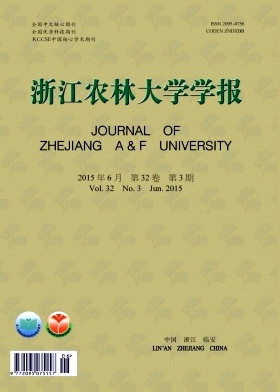Bambusa textilis var. fasca shooting and young bamboo growth rhythm
doi: 10.11833/j.issn.2095-0756.2015.03.022
- Received Date: 2014-09-15
- Rev Recd Date: 2014-11-17
- Publish Date: 2015-06-20
-
Key words:
- silviculture /
- Bambusa textilis var. fasca /
- shooting period /
- height-growth rhythm of young bamboo /
- burgeon branches and leaves of young bamboo /
- cold-resistance
Abstract: To utilize Bambusa textilis var. fasca, a cold-resistance sympodial bamboo species scientifically, the natural shooting and young bamboo growth rhythm of B. textilis var. fasca in Jianou, Fujian Province was observed every two days. Shooting period was determined with an ordered sample cluster analysis and height-growth was simulated with the Logistic and Richards models. Results showed that the natural shooting period of B. textilis var. fasca lasted from mid-May to early November, and the highest rate of adult bamboo formed was 85.5% in mid-July. A three stage shooting period was noted: an initial stage (mid-May to early June), an abundant stage (mid-June to mid-September), and an ending stage (late September to early November). In the abundant stage, shoot number was 80.7% of the total, and the rate of adult bamboo formed was 70.7%. The earlier the bamboo shoots emerged (June and July), the longer their height-growth period was (116 d); the average height of young bamboo with an August shooting period was 7.8 m. The Logistic and Richards models, simulated the slow-fast-slow law for height-growth well. The beginning culm sheath abscission time for young bamboo with shooting periods in June, July, August, and September was late July, late August, early September, and mid-October, respectively. The beginning culm branch extraction time for shooting periods in June and July was late September but for a shooting period of August was mid-October. New culms with shooting before mid-August could complete the whole process of burgeoning branches and leaves in the same year; whereas, a shooting period later than mid-August meant completion the following April to May. New culms with a shooting period in the ending stage rarely dropped sheaths or burgeoned new branches and subjected to low temperature and freezing easily in winter. This study has laid a foundation for silviculture and seedling breeding of B. textilis var. fasca [Ch, 4 fig. 14 ref.]
| Citation: | ZHANG Wei, LIN Zhenqing, YANG Qianyu, CHEN Zheyong, XIE Jinzhong. Bambusa textilis var. fasca shooting and young bamboo growth rhythm[J]. Journal of Zhejiang A&F University, 2015, 32(3): 478-482. doi: 10.11833/j.issn.2095-0756.2015.03.022 |






 DownLoad:
DownLoad: